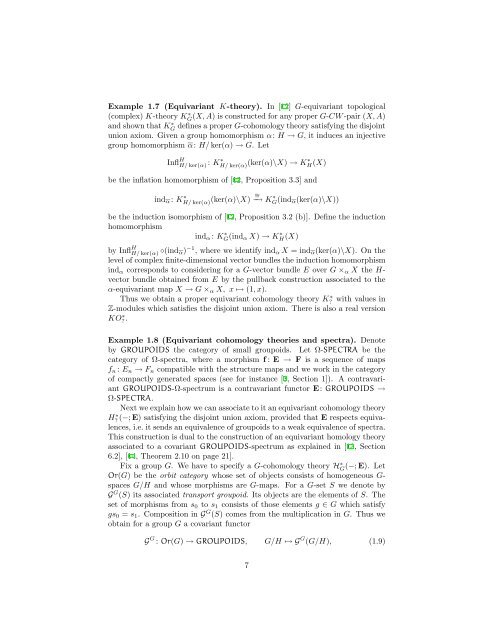Equivariant Cohomological Chern Characters
Equivariant Cohomological Chern Characters
Equivariant Cohomological Chern Characters
Create successful ePaper yourself
Turn your PDF publications into a flip-book with our unique Google optimized e-Paper software.
Example 1.7 (<strong>Equivariant</strong> K-theory). In [12] G-equivariant topological(complex) K-theory KG ∗ (X, A) is constructed for any proper G-CW -pair (X, A)and shown that KG ∗ defines a proper G-cohomology theory satisfying the disjointunion axiom. Given a group homomorphism α: H → G, it induces an injectivegroup homomorphism α: H/ ker(α) → G. LetInfl H H/ ker(α) : K ∗ H/ ker(α) (ker(α)\X) → K∗ H(X)be the inflation homomorphism of [12, Proposition 3.3] andind α : K ∗ H/ ker(α) (ker(α)\X) ∼= −→ K ∗ G(ind α (ker(α)\X))be the induction isomorphism of [12, Proposition 3.2 (b)]. Define the inductionhomomorphismind α : K ∗ G(ind α X) → K ∗ H(X)by Infl H H/ ker(α) ◦(ind α ) −1 , where we identify ind α X = ind α (ker(α)\X). On thelevel of complex finite-dimensional vector bundles the induction homomorphismind α corresponds to considering for a G-vector bundle E over G × α X the H-vector bundle obtained from E by the pullback construction associated to theα-equivariant map X → G × α X, x ↦→ (1, x).Thus we obtain a proper equivariant cohomology theory K? ∗ with values inZ-modules which satisfies the disjoint union axiom. There is also a real versionKO? ∗ .Example 1.8 (<strong>Equivariant</strong> cohomology theories and spectra). Denoteby GROUPOIDS the category of small groupoids. Let Ω-SPECTRA be thecategory of Ω-spectra, where a morphism f : E → F is a sequence of mapsf n : E n → F n compatible with the structure maps and we work in the categoryof compactly generated spaces (see for instance [3, Section 1]). A contravariantGROUPOIDS-Ω-spectrum is a contravariant functor E: GROUPOIDS →Ω-SPECTRA.Next we explain how we can associate to it an equivariant cohomology theoryH? ∗ (−; E) satisfying the disjoint union axiom, provided that E respects equivalences,i.e. it sends an equivalence of groupoids to a weak equivalence of spectra.This construction is dual to the construction of an equivariant homology theoryassociated to a covariant GROUPOIDS-spectrum as explained in [13, Section6.2], [14, Theorem 2.10 on page 21].Fix a group G. We have to specify a G-cohomology theory HG ∗ (−; E). LetOr(G) be the orbit category whose set of objects consists of homogeneous G-spaces G/H and whose morphisms are G-maps. For a G-set S we denote byG G (S) its associated transport groupoid. Its objects are the elements of S. Theset of morphisms from s 0 to s 1 consists of those elements g ∈ G which satisfygs 0 = s 1 . Composition in G G (S) comes from the multiplication in G. Thus weobtain for a group G a covariant functorG G : Or(G) → GROUPOIDS, G/H ↦→ G G (G/H), (1.9)7
















